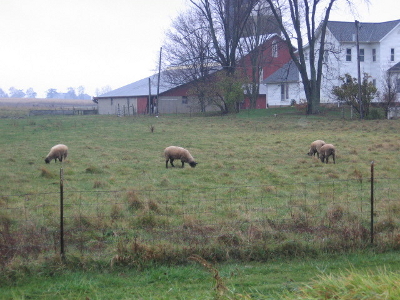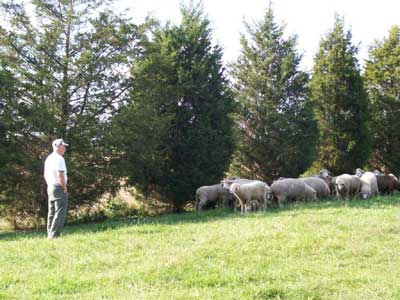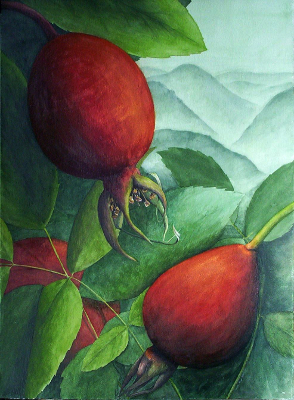
Permanent pasture fences
 One of my favorite parts of All Flesh
is Grass is
Logsdon's fencing advice. Every other book and blog I've read
about rotational grazing sings the praises of temporary electric
fences, but Logsdon and I both aren't
fans of electric fences.
One of my favorite parts of All Flesh
is Grass is
Logsdon's fencing advice. Every other book and blog I've read
about rotational grazing sings the praises of temporary electric
fences, but Logsdon and I both aren't
fans of electric fences.
Logsdon started out his
operation with woven wire fences, mostly because he found a lot of free
materials. He uses heavy wooden posts that are nearly eight feet
long, driven two and a half to three feet in the ground and separated
by fifteen feet along the fenceline. As an old-fashioned farmer,
he likes posts he can cut himself --- red cedar, black locust, catalpa,
osage-orange --- but he will also split old electric poles or
railroad ties into thinner sections to use as fenceposts. His
corner posts are eight inch in diameter treated lumber, nine feet long,
sunk four feet into the ground, and braced. After pulling the
woven wire taut between these fence posts (and, yes, I was exhausted
before I even got to that part of the description), Logsdon adds a
strand of electric fence over top of the woven wire as a final line of
defense.
All of that said,
Logsdon is now changing over to livestock panels. These four foot
tall and sixteen feet long fence sections can be used on uneven
terrain, don't collapse if a tree limb falls on them, are modular and
easy to replace piecemeal, and are rated to last twice as long as woven
wire fences (for twice the price, of course). Installation is
easy --- just set a post every eight feet, with panels overlapping two
inches at the each end. After a year of closing up the holes Lucy
made in our chicken wire fences (and watching Mark swear as he tried to
stretch the fences up hills), I'm wishing we'd gone the livestock panel
route as well. Maybe for our next fences!
 While we're on the topic of
fencing, I should add that one benefit of permanent fences is that you
can plant trees long the fenceline, adding another layer of
productivity to the pasture while making animals less likely to break
through. Logsdon has tried many different types of trees and
sings the praises of apples and peaches (both grown from seed), pears,
thornless honey locusts, and chinquapin oaks for
providing extra food for livestock. Red cedars make a good
windbreak and don't taste good to livestock, so you don't have to fence
the animals away from the young trees as carefully, plus you can use
them to make fence posts.
While we're on the topic of
fencing, I should add that one benefit of permanent fences is that you
can plant trees long the fenceline, adding another layer of
productivity to the pasture while making animals less likely to break
through. Logsdon has tried many different types of trees and
sings the praises of apples and peaches (both grown from seed), pears,
thornless honey locusts, and chinquapin oaks for
providing extra food for livestock. Red cedars make a good
windbreak and don't taste good to livestock, so you don't have to fence
the animals away from the young trees as carefully, plus you can use
them to make fence posts.
On the other hand,
Logsdon has tried some trees he wouldn't plant in a pasture
again. Weeping willows and black walnuts love to drop limbs all
over the fenceline, black locust leaves are toxic to animals, and
cherries not only have poisonous leaves, they also don't make very
tasty fruits if grown from seed. In addition, even if you plant
the best-behaved  trees,
you'll need to spend a day every year cutting out grapevines, poison
ivy, and tree seedlings growing along your fencerow, but you'd spend
the same time weed-eating if you didn't have trees.
trees,
you'll need to spend a day every year cutting out grapevines, poison
ivy, and tree seedlings growing along your fencerow, but you'd spend
the same time weed-eating if you didn't have trees.
I've always liked the
idea of turning fencelines into productive zones, but with our small
pastures, trees are out of the question. However, when I bought
the scionwood
for our pear tree, I
threw in a couple of shrubs that are supposed to make good, thorny
hedges while providing edibles for chickens --- Rosa
rugosa and
Siberian pea shrub. Meanwhile, the timber
bamboo (Phyllostachys
vivax) that I
planted last year seems to be holding its ground. Maybe in
another five years or so, our fences will be lost in a sea of edible
and beautiful greenery.
| This post is part of our All Flesh is Grass lunchtime series.
Read all of the entries: |
Want more in-depth information? Browse through our books.
Or explore more posts by date or by subject.
About us: Anna Hess and Mark Hamilton spent over a decade living self-sufficiently in the mountains of Virginia before moving north to start over from scratch in the foothills of Ohio. They've experimented with permaculture, no-till gardening, trailersteading, home-based microbusinesses and much more, writing about their adventures in both blogs and books.
Want to be notified when new comments are posted on this page? Click on the RSS button after you add a comment to subscribe to the comment feed, or simply check the box beside "email replies to me" while writing your comment.

Since I do not plan on raising large live stock, I want to avoid the expance of fencng.
We do have chickens and hope to raise up some geese this summer, so we plan on the movable fencing like you have for your chickens free range.
Thank you for that idea.
I like the idea of old-fashioned hedgerows, but growing trees up along a fenceline can be much more of a pain than it seems. Our pastures are pretty well locked in to their shapes because the old barbed wire fencing has allowed a tangle of weedy trees, shrubs and brambles to grow up. It's great for the birds (they've been busily planting this fenceline for the past 30 years) but the fence is useless to us now- rusted and collapsed in some areas, and the tree line isn't secure enough to serve as a living fence itself (most of these species, goats would just eat through it). I am slowly chopping down and replacing some of the invasives with more useful plants, but it's quite a task. To remove the fencelines, which is what I would like to do now, would cost so much in labor alone that it's just not feasible. We have 4 paddocks across 20 acres. I'll probably end up just breaking through the fencelines here and there to get better access to all of the pastures, but it will be a long time before I'm able to get all of the old fencing pulled up to make the pastures more functional for what I want to do.
I like the perimeter fence. Over time it seems that you just have to keep moving the fence in further and further because old, overgrown fencelines are nearly impossible to maintain. For the perimeter, I'd recommend either fences OR well designed hedgerows that are suitable for the species you want to raise. Or a layer of one after the other. I wouldn't want to do both on top of each other, especially if the plant species can't hold their own after the fence is no longer useful. For the interior paddocks, I'm still planning to go with electric fencing. I don't want to add any new, 'permanent' obstructions to the fields. Living with someone else's fencing decisions has been a huge headache, and pasturing practices continue to change. Changes may come again and I'd find it too troublesome to be stuck with an outdated arrangement.
Heath --- Fencing materials are expensive. On the other hand, they also take a lot of labor to put up and take down. With that type of homesteading infrastructure, I generally just start small and pay for as much or as little of the good stuff as we can. After all, if you can't afford good fences, you probably can't afford good livestock, and you probably don't have the time to take care of large expanses of pasture either.
Mona --- We're very pleased with our temporary fencing for moving chickens around the garden. If you've got a congested homestead and are just running poultry, you're probably on the right track to stick to temporary!
Sara --- It sounds like you're dealing with a tough fencing situation! I think the key to putting trees along fencelines is choosing perennials that don't drop too many limbs, committing to maintain the fencerows every year, and using solid fencing like livestock panels. Logsdon goes through and weeds his fenceline every year, which is one option, or you can choose hedging perennials and weave them together every year so they eventually replace the fence. It sounds like the previous owners at your place didn't do that, which does seem to turn it into a nightmare. We're still pulling up old fencing that fell into the soil from fifty years ago.
I think it's also helpful to start small with living and permanent fences. Logsdon began by fencing the perimeter, then slowly divided the pasture area up as he learned the land and his own pasturing arrangement. (To go back to Heath's comment, that makes it much more financially feasible too.)
I've heard of using living fences for ornamental purposes but never for livestock. I find this intriguing. Do you know what kinds of perennial plants/shrubs are generally good if you want to go that route?
~ Mitsy
Mitsy --- I've been looking for a good book on edible hedges (or even inedible hedges) and haven't found one yet. However, I've been posting tidbits on the blog as I come across them. Here are some ideas on edible hedges and traditional British hedge plants.
If you run across something more definitive, I hope you'll let me know!
Congratulations on the book! I knew you could do it and I expect that it will sell well.
The photo on the fence item looks very familiar!!! I do enjoy looking at the painting hanging in my house.